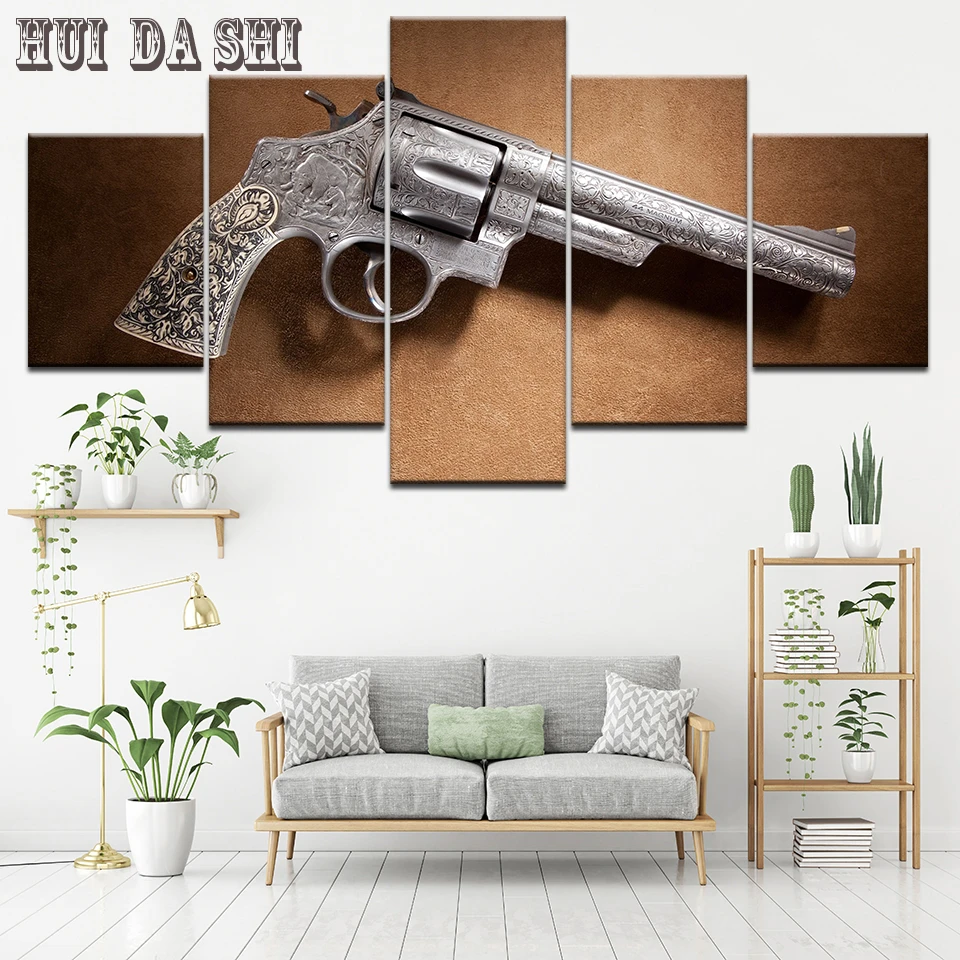Old School Revolver - While today's best pistols are modern marvels of speed and accuracy, it would be a mistake to forget the classic pistols that got us here. Samuel Colt started the evolution of the revolver with his revolver, which appeared in the late 1800s and was popularized by real cowboys and then countless westerns on the silver screen. In the decades between the Colt revolver and today's modern handguns, there is a long list of weapons that American shooters should know and have in their gun safes. My task was to pick my seven favorites. The firearms that followed influenced many of the revolvers and semi-automatics we carry today.
Sam Colt was bored while crossing the ocean in a boat in 1830 and to pass the time he carved a wooden model of a repeating gun. He is said to have invented the modern revolver as a result.
Old School Revolver
Colt later made a huge mistake when he rejected the idea of one of his gunsmiths, Rollin White, who wanted to "focus" the revolver cylinder to allow the use of metal cartridges in the gun. After Colt fired White for daring to suggest improvements to his pistol design, White took his idea to Smith & Wesson. They patented his invention and prevented Colt from making firearms for nearly 20 years.
Review: Charter Arms Classic Bulldog
When the S&W patent expired in 1873, Colt introduced the Single Action Army Pistol in .45 Colt, perhaps the most famous revolver in history. We see it in every western movie, Marshal Dillon draws it at the beginning of every episode of Gunsmoke, and it's the gun everyone thinks of when they hear "cowboy gun."
The 1873 Winchester rifle was called "The Gun That Won the West" and rightly so. However, the United States military was on his side. Colt's single-action army, chambered in the .45 Colt centerfire cartridge, ushered in the modern era of the handgun. His mark on the history of the gun is indelible and profound.
For many handgun shooters, there is only one combat pistol: the 1911. Many Internet pundits believe that it is an old design that is compartmentalized for unnecessarily large cartridges and does not hold enough ammunition. I think everyone is entitled to their opinion, but anyone who thinks the platform is outdated is wrong.
1911 has been through two world wars and more than 100 years of military, law enforcement and civilian use. This gun has won every type of gun competition on earth. The indisputable truth is that the 1911 has more than proven its durability, reliability, stopping power and accuracy.
Iconic Illustration Of A Vintage Revolver Isolated On White Stock Image
.45 ACP dates back to the war the United States fought in the Philippines from 1899 to 1902. The US military used double-action revolvers in an anemic cartridge called the .38 Long Colt. But too many of our fighters were killed with knives, even after hitting the enemy with every round of the weapon. This experience, along with the controversial Thompson-LaGarde test in 1904, led the Army and Cavalry to require a minimum caliber of .45 in the new military pistol. John Browning developed the .45 ACP in 1904 and adapted it to the 1911 Browning semi-automatic pistol.
While both the pistol and the cartridge have been updated quite a bit, the 1911 remains, at least in the minds of many experienced people, the ultimate pistol and cartridge team. There are countless variations of the 1911 out there today, including some very cool models like the President Nighthawk Custom. The only downside is the relatively small magazine capacity, at least by today's standards.
The Browning Hi-Power was John Moses Browning's last pistol design. He was working on it when he died.

The Hi-Power was introduced in 1935. A cult defensive pistol, the Hi-Power has seen much service in law enforcement and the military, particularly in Europe. The design is a bit old and dated by today's standards, but the Hi-Power is still a relatively small, all-metal pistol with a long history of reliable performance. The double 9mm magazine holds 13 rounds and some aftermarket magazines hold 15 rounds.
The New Snub Nose Revolver Taylor's & Company Ace \
The ball is not without its critics. It has a magazine safety that prevents the gun from firing without loading the magazine. This is undesirable and unnecessary in a combat weapon. Also, the hammer can hit the shooter's hand because the short stock doesn't protect you from the hammer strike. A bloody hand is a common complaint of Hi-Power shooters.
Browning discontinued the pistol in 2017, but the market has recently seen several clones, such as the Springfield SA-35 and FN High Power, that overcome some of the weaknesses of the original design. It was a great weapon to still have legs in these new iterations. There are much better options today, but for years the Hi-Power was the ultimate 9mm pistol.
Before 1935, pistols were primarily defensive tools. Relatively low capacity, they are not considered hunting or even sporting weapons. Then came the .357 Magnum and the S&W Registered revolver. This pistol became the Model 27, and while the Model 27 was important to the police, it also gave birth to the modern civilian idea of magnum revolvers.
The gun used a large N frame and was a highly polished work of art. Later S&W introduced the cheaper and less polished Model 28. That was my first gun. Like an idiot I replaced it.
Retro Revolver Roze Bloem En Woorden Dood Voordat Dishonor Klassieke Amerikaanse Old School Tattoo Vector Illustratie Op Een Witte Achtergrond Stockvectorkunst En Meer Beelden Van Tekenen
In 1955, the N frame was used again to introduce the new .44 Magnum cartridge and the Model 29 revolver. This may be the best modern revolver, in large part because Clint Eastwood used it in the Dirty Harry movies.
There was a time when every serious pistol shooter owned one or both of these guns. I can remember the early days of IHMSA competition when 75 percent of new shooters showed up with a Model 29. Gun writer Elmer Keith had a hand in developing both cartridges. He released the .44 Magnum before Clint ever got it. His story of hitting a wounded mule deer at 600 yards with his .44 magnum is legendary.
The N-frame, .357 Magnum, and later .44 Magnum, revolvers are probably more responsible than any other firearm for starting the sport of handgun hunting. They can kill any deer cleanly and the .44 Magnum is capable of taking some of the biggest game in the world.

Millions of Mosin-Nagant rifles, which were standard issue for Russian soldiers in their fight against the Nazis during World War II, flooded the surplus market just a few years ago. Handguns, mostly chambered in 7.62x54mm R, became popular due to cheap ammunition. Not many know that Leon and Emil, the Nagant brothers, were also making weapons for the Russians. Their revolver was a marvel of engineering with its sliding barrel and long pin.
Thoughts: Handgun Stopping Power
It used a special 7.62 mm cartridge, the bullet of which was buried in the bottom of the case. The muzzle of the case is ejected and when the weapon is cocked, the cylinder moves forward until this inflated case engages the rear of the barrel. This seals everything and eliminates the problems associated with the normal cylinder-barrel gap found in traditional revolvers.
Once the cylinder was moved to the forward position, the deep penetration in the gun meant that the floating bullet mounted in the hammer was more than a quarter of an inch long. So when the Nagant dives, it has a very distinctive profile.
The Nagant revolver was manufactured in two designs, a double action for officers and a single action for the general public. By 1933, Russia began to replace the pistol with the Tokarev semi-automatic pistol. In 1952, with the introduction of the Makarov pistol, the military completely abandoned it. The Nagant was used for many years by Russian Railways, the postal service and the police. In fact, the Postal Security Service used it until 2003.
Working in his home shop in New Hampshire, Warren St. developed a unique single-shot fragmentation pistol. In 1965 the center was awarded to K.B. Thompson Tool Company and introduced the gun as the Thompson-Center Contender in 1967. the gun could easily change barrels so you could buy a gun and some barrels. The sights or scale stayed with the barrel so it would hold zero when you changed it. The gun was originally chambered for low pressure, low recoil cartridges such as the .22 LR, .22 WMR, .22 Hornet, .38 Special and .22 Remington Jet.
Korth Classic High Polished Blue Dlc
They added more cartridge options, including a .45 Colt/.410 cartridge version. T/K abandoned the .410-barrel in favor of the .44 Magnum and .357 Magnum, which use plastic shock capsules. I actually have one in .44 mag. They later brought back the .45/.410 and I bought it right away. I can't tell you how many times I've played with myself - sheep, rabbits, souks and even guinea pigs, but it's a lot.
The plaintiff did not sell very well at first. It was very "different". Then IHMSA long distance competition shooting began
Old school white nike, old school jeans women, old school audiobook, old fashioned revolver, old west revolver holster, mens old school fashion, old 44 revolver, how old is my colt revolver, vans old school trainers, old school crewneck, old western revolver, old revolver parts
0 Comments